Page 436 of 590
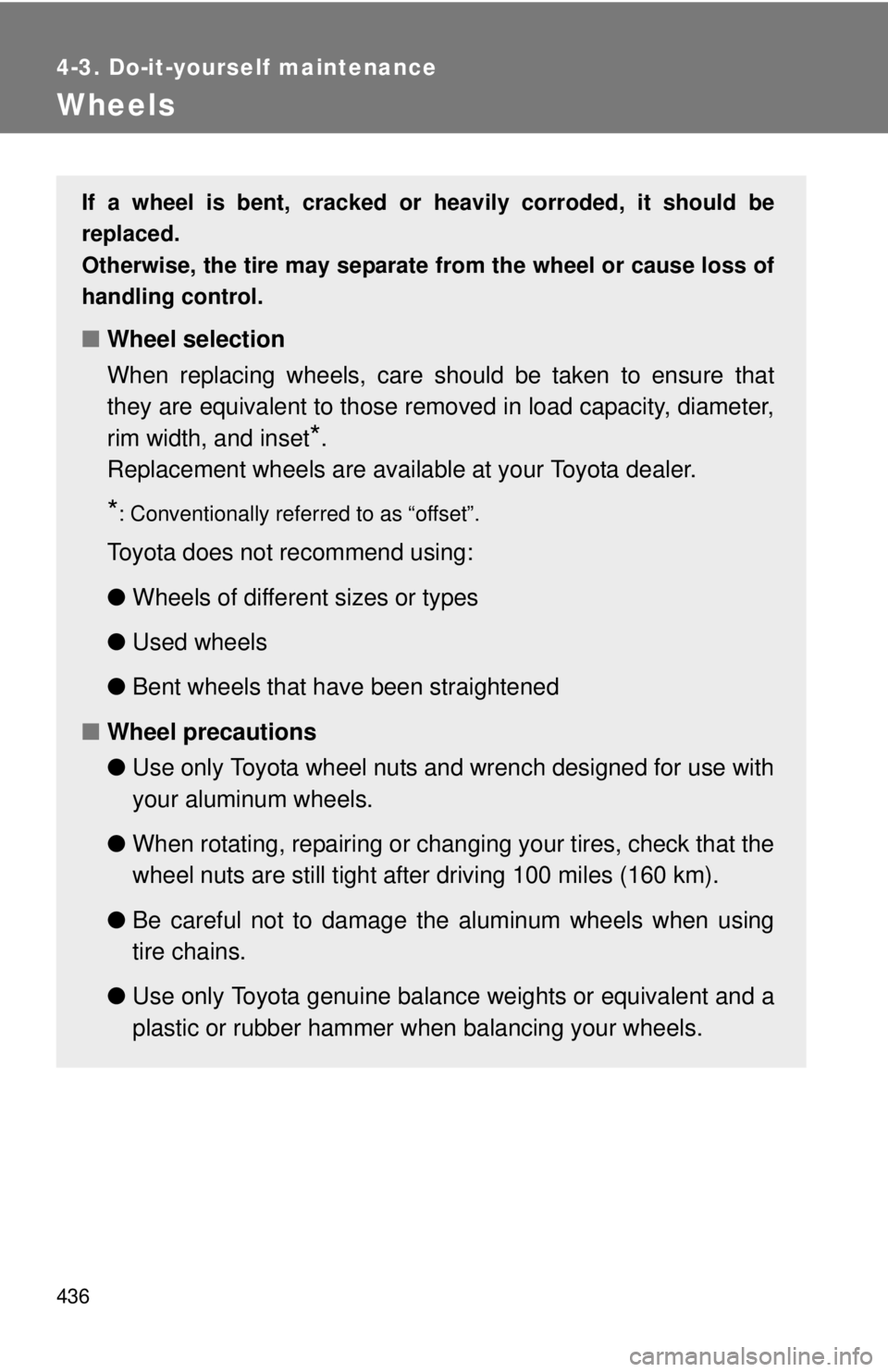
436
4-3. Do-it-yourself maintenance
Wheels
If a wheel is bent, cracked or heavily corroded, it should be
replaced.
Otherwise, the tire may separate from the wheel or cause loss of
handling control.
■Wheel selection
When replacing wheels, care should be taken to ensure that
they are equivalent to those removed in load capacity, diameter,
rim width, and inset
*.
Replacement wheels are available at your Toyota dealer.
*: Conventionally referred to as “offset”.
Toyota does not recommend using:
● Wheels of different sizes or types
● Used wheels
● Bent wheels that have been straightened
■ Wheel precautions
●Use only Toyota wheel nuts and wrench designed for use with
your aluminum wheels.
● When rotating, repairing or changing your tires, check that the
wheel nuts are still tight after driving 100 miles (160 km).
● Be careful not to damage the aluminum wheels when using
tire chains.
● Use only Toyota genuine balance weights or equivalent and a
plastic or rubber hammer when balancing your wheels.
Page 482 of 590

482 5-2. Steps to take in an emergency
■Key reminder buzzer
The buzzer indicates that the key has not been removed (with the engine
switch in the ACC or LOCK position and the driver’s door opened).
■ If the malfunction indicator lamp comes on while driving
First check the following:
● Is your vehicle low on gas?
If it is, refuel the vehicle immediately.
● Is the fuel tank cap loose?
If it is, tighten it securely.
The light will go off after taking several driving trips.
If the light does not go off even after several trips, contact your Toyota dealer
as soon as possible.
■ Front passenger detect ion sensor and passenger seat belt reminder
If luggage or other load is placed on the front passenger seat, depending on
its weight, the reminder light to flash and buzzer to sound.
■
When the tire pressure warning light comes on
Check the tire inflation pressure and adjust to the appropriate level.
Pushing the tire pressure warning reset switch does not turn off the tire
pressure warning light.
■The tire pressure warning light ma y turn on due to natural causes
The tire pressure warning light may turn on due to natural causes such
as natural air leaks or tire inflation pressure changes caused by temper-
ature. In this case, adjusting the ti re inflation pressure will turn off the
warning light (after a few minutes).
■When a tire is replaced with a spare tire
The temporary spare tire is not equipped with the tire pressure warning
valve and transmitter. If a tire goes flat, the tire pressure warning light will
not turn off even though the flat tire is replaced with the temporary spare
tire. Replace the temporary spare tire with the repaired tire and adjust
the proper tire inflatio n pressure. The tire pres sure warning light will turn
off after a few minutes.
Page 520 of 590
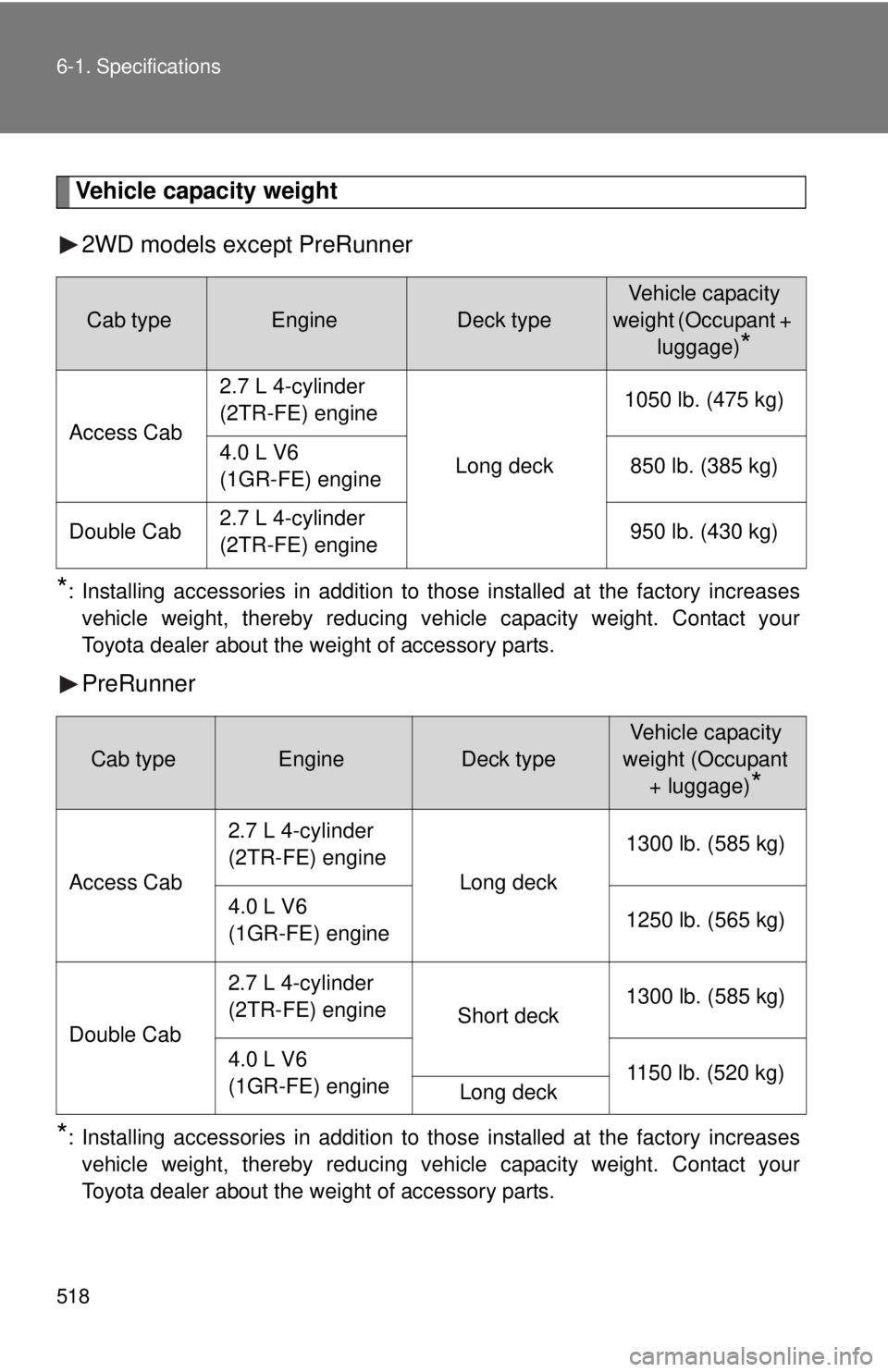
518 6-1. Specifications
Vehicle capacity weight2WD models except PreRunner
*: Installing accessories in addition to those installed at the factory increases vehicle weight, thereby reducing vehicle capacity weight. Contact your
Toyota dealer about the weight of accessory parts.
PreRunner
*: Installing accessories in addition to those installed at the factory increasesvehicle weight, thereby reducing vehicle capacity weight. Contact your
Toyota dealer about the weight of accessory parts.
Cab typeEngineDeck type
Vehicle capacity
weight (Occupant + luggage)
*
Access Cab
2.7 L 4-cylinder
(2TR-FE) engine
Long deck
1050 lb. (475 kg)
4.0 L V6
(1GR-FE) engine850 lb. (385 kg)
Double Cab
2.7 L 4-cylinder
(2TR-FE) engine950 lb. (430 kg)
Cab typeEngineDeck type
Vehicle capacity
weight (Occupant + luggage)
*
Access Cab
2.7 L 4-cylinder
(2TR-FE) engine
Long deck 1300 lb. (585 kg)
4.0 L V6
(1GR-FE) engine
1250 lb. (565 kg)
Double Cab
2.7 L 4-cylinder
(2TR-FE) engine
Short deck 1300 lb. (585 kg)
4.0 L V6
(1GR-FE) engine
1150 lb. (520 kg)
Long deck
Page 521 of 590
519
6-1. Specifications
6
Vehicle specifications
4WD models
*: Installing accessories in addition to those installed at the factory increases
vehicle weight, thereby reducing vehicle capacity weight. Contact your
Toyota dealer about the weight of accessory parts.
TWR (Trailer Weight Rating)
Access Cab models
Cab typeEngineDeck type
Vehicle capacity
weight (Occupant + luggage)
*
Access Cab
2.7 L 4-cylinder
(2TR-FE) engine
Long deck 1200 lb. (540 kg)4.0 L V6
(1GR-FE) engine
1140 lb. (515 kg)
Double Cab
4.0 L V6
(1GR-FE) engineShort deck 1040 lb. (470 kg)
Long deck
Model code*1EngineDriving
systemTWR
TRN225L-CRMDKA
2.7 L 4-cylinder
(2TR-FE) engine
2WD
3500 lb. (1585 kg)
TRN225L-CRPDKA
TRN245L-CRMDKA
4WD
TRN245L-CRPDKA
TRN265L-CRPDKA
2WD
GRN225L-CRFDKA
4.0 L V6 (1GR-FE)
engine 3300 lb. (1495 kg)
GRN245L-CRADKA4WD 3500 lb. (1585 kg)
*2
6500 lb. (2945 kg)*3
GRN245L-CRFDKA
3500 lb. (1585 kg)*2
6500 lb. (2945 kg)*3
GRN265L-CRADKA2WD3500 lb. (1585 kg)*2
6500 lb. (2945 kg)*3
Page 547 of 590
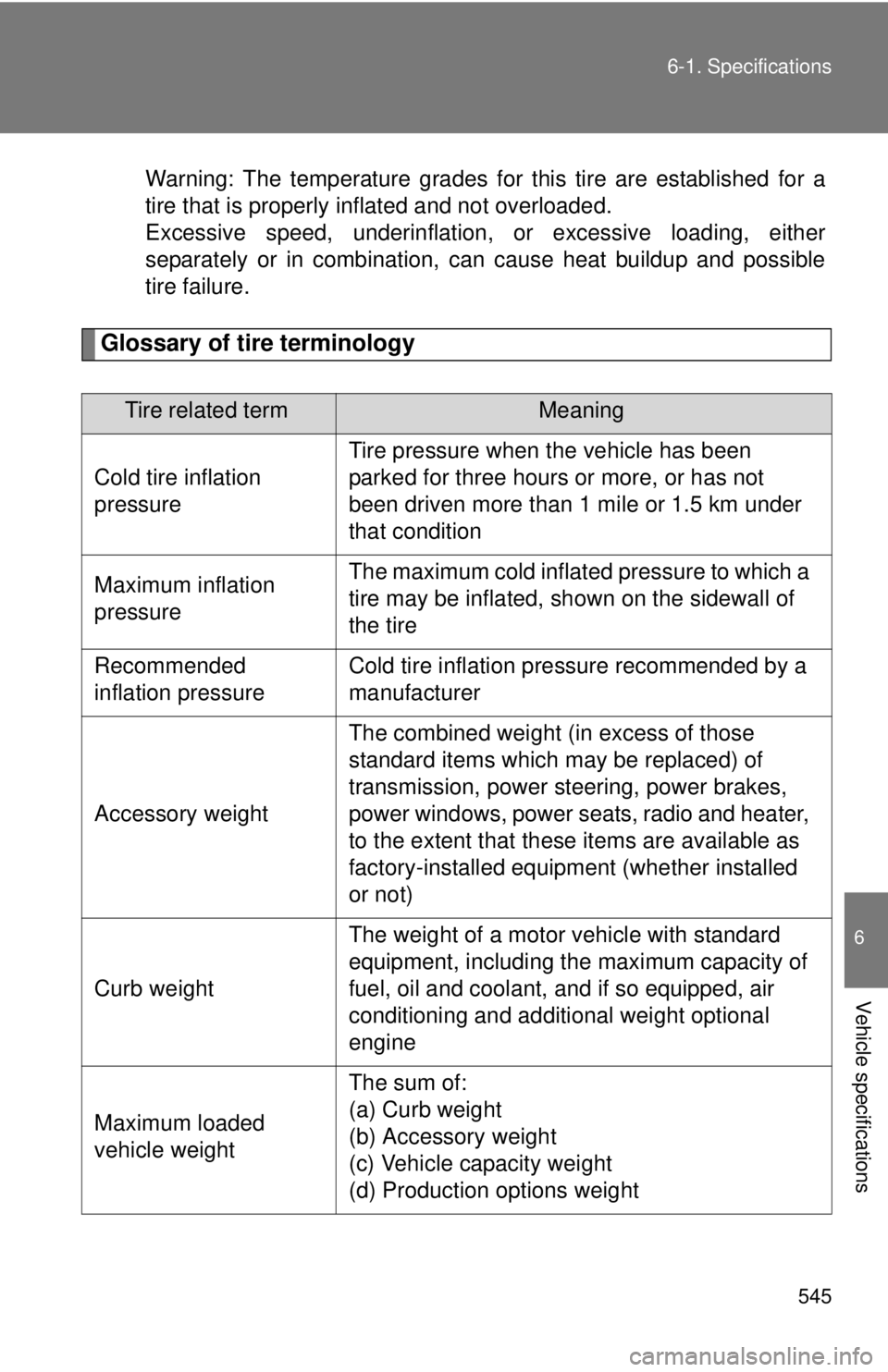
545
6-1. Specifications
6
Vehicle specifications
Warning: The temperature grades for this tire are established for a
tire that is properly inflated and not overloaded.
Excessive speed, underinflation,
or excessive loading, either
separately or in combination, can cause heat buildup and possible
tire failure.
Glossary of tire terminology
Tire related termMeaning
Cold tire inflation
pressure
Tire pressure when the vehicle has been
parked for three hours or more, or has not
been driven more than 1 mile or 1.5 km under
that condition
Maximum inflation
pressureThe maximum cold inflated pressure to which a
tire may be inflated, s hown on the sidewall of
the tire
Recommended
inflation pressureCold tire inflation pressure recommended by a
manufacturer
Accessory weight
The combined weight (in excess of those
standard items which may be replaced) of
transmission, power steering, power brakes,
power windows, power seats, radio and heater,
to the extent that these items are available as
factory-installed equipment (whether installed
or not)
Curb weight
The weight of a motor vehicle with standard
equipment, including the maximum capacity of
fuel, oil and coolant, and if so equipped, air
conditioning and additional weight optional
engine
Maximum loaded
vehicle weight
The sum of:
(a) Curb weight
(b) Accessory weight
(c) Vehicle capacity weight
(d) Production options weight
Page 548 of 590
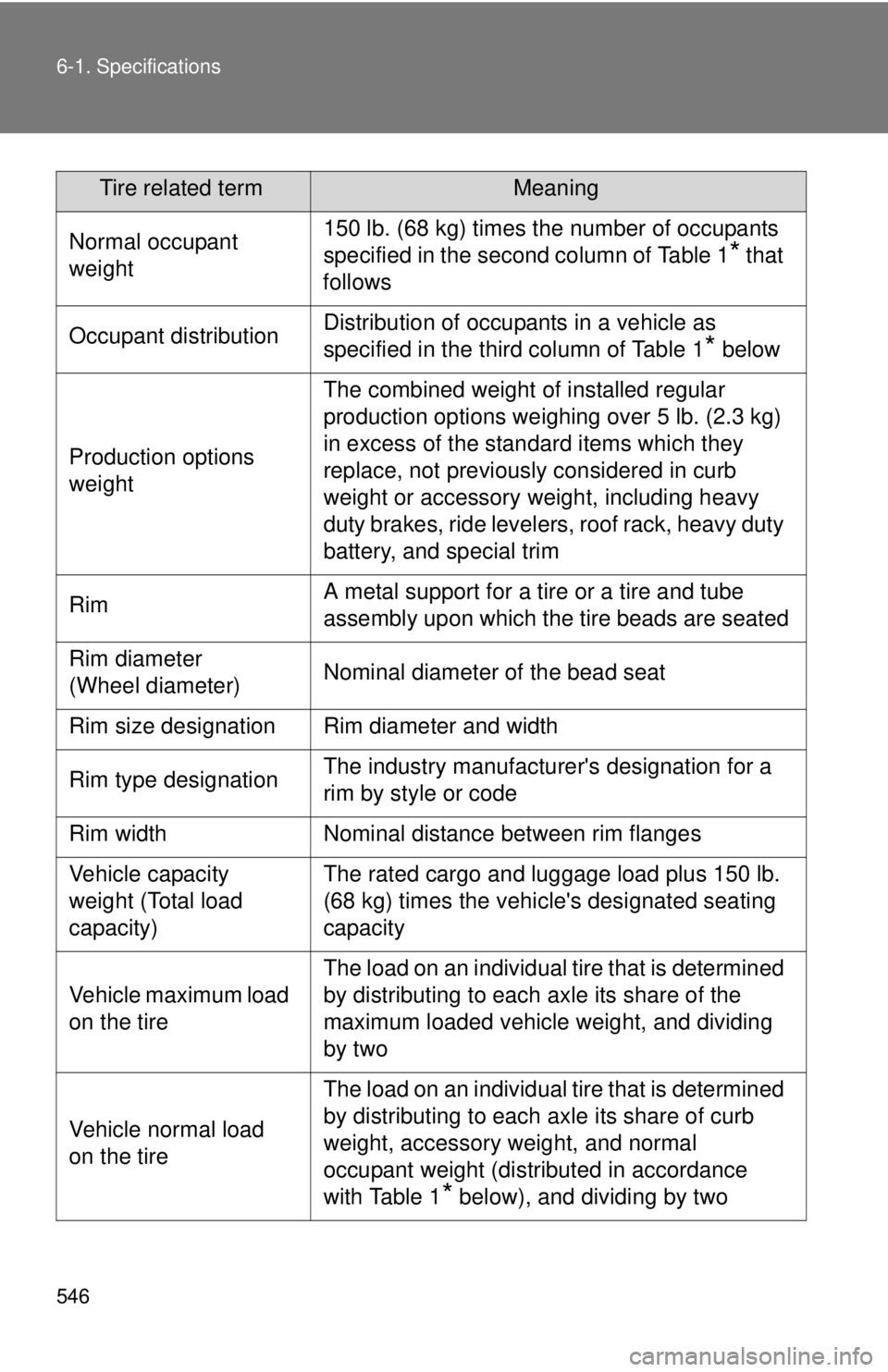
546 6-1. Specifications
Normal occupant
weight150 lb. (68 kg) times the number of occupants
specified in the second column of Table 1
* that
follows
Occupant distributionDistribution of occupants in a vehicle as
specified in the third column of Table 1
* below
Production options
weight
The combined weight of installed regular
production options weighing over 5 lb. (2.3 kg)
in excess of the standard items which they
replace, not previously considered in curb
weight or accessory weight, including heavy
duty brakes, ride levelers, roof rack, heavy duty
battery, and special trim
RimA metal support for a tire or a tire and tube
assembly upon which the tire beads are seated
Rim diameter
(Wheel diameter)Nominal diameter of the bead seat
Rim size designationRim diameter and width
Rim type designationThe industry manufacturer's designation for a
rim by style or code
Rim widthNominal distance between rim flanges
Vehicle capacity
weight (Total load
capacity)The rated cargo and luggage load plus 150 lb.
(68 kg) times the vehicl e's designated seating
capacity
Vehicle maximum load
on the tire
The load on an individual tire that is determined
by distributing to each axle its share of the
maximum loaded vehicle weight, and dividing
by two
Vehicle normal load
on the tire
The load on an individual tire that is determined
by distributing to each axle its share of curb
weight, accessory weight, and normal
occupant weight (distr ibuted in accordance
with Table 1
* below), and dividing by two
Tire related termMeaning
Page 550 of 590
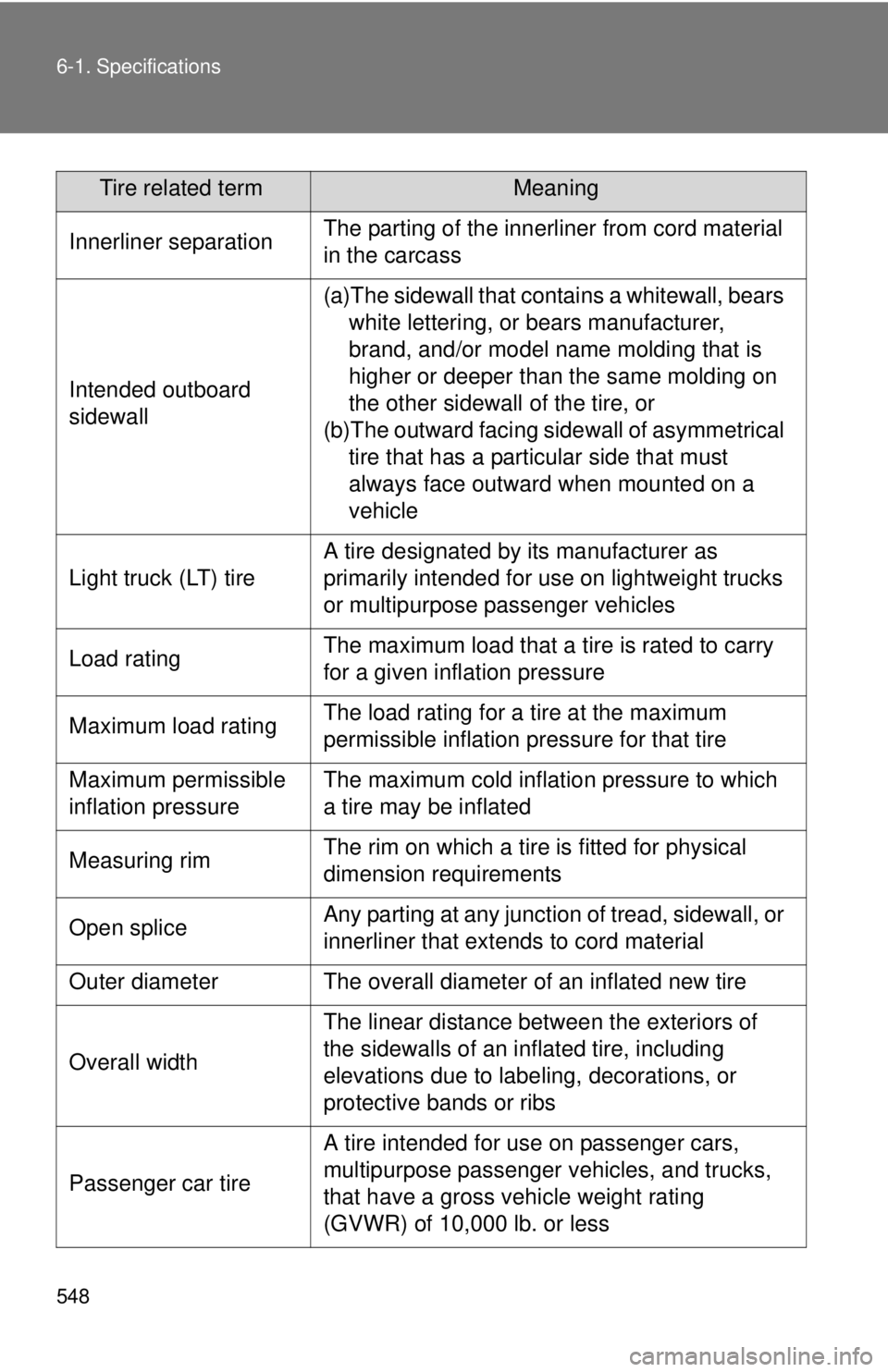
548 6-1. Specifications
Innerliner separationThe parting of the innerliner from cord material
in the carcass
Intended outboard
sidewall
(a)The sidewall that contains a whitewall, bears white lettering, or bears manufacturer,
brand, and/or model name molding that is
higher or deeper than the same molding on
the other sidewall of the tire, or
(b)The outward facing sidewall of asymmetrical tire that has a particular side that must
always face outward when mounted on a
vehicle
Light truck (LT) tire
A tire designated by its manufacturer as
primarily intended for use on lightweight trucks
or multipurpose passenger vehicles
Load ratingThe maximum load that a tire is rated to carry
for a given inflation pressure
Maximum load ratingThe load rating for a tire at the maximum
permissible inflation pressure for that tire
Maximum permissible
inflation pressureThe maximum cold inflation pressure to which
a tire may be inflated
Measuring rimThe rim on which a tire is fitted for physical
dimension requirements
Open spliceAny parting at any junction of tread, sidewall, or
innerliner that extends to cord material
Outer diameterThe overall diameter of an inflated new tire
Overall width
The linear distance between the exteriors of
the sidewalls of an inflated tire, including
elevations due to labeling, decorations, or
protective bands or ribs
Passenger car tire
A tire intended for use on passenger cars,
multipurpose passenger vehicles, and trucks,
that have a gross vehicle weight rating
(GVWR) of 10,000 lb. or less
Tire related termMeaning
Page 554 of 590
552
6-2. Customization
Items to initialize
ItemWhen to initializeReference
Maintenance required
reminder lightAfter the maintenance is per-
formedP. 395
Tire pressure warning sys-
tem
• When rotating the tires on vehi-cles differing with front and rear
tire inflation pressures.
• When changing the tire inflation pressure by changing traveling
speed or load weight, etc.
• When changing the tire size.
P. 423
The following items must be initia lized for normal system operation
in cases such as after the battery is reconnected, or maintenance is
performed on the vehicle.